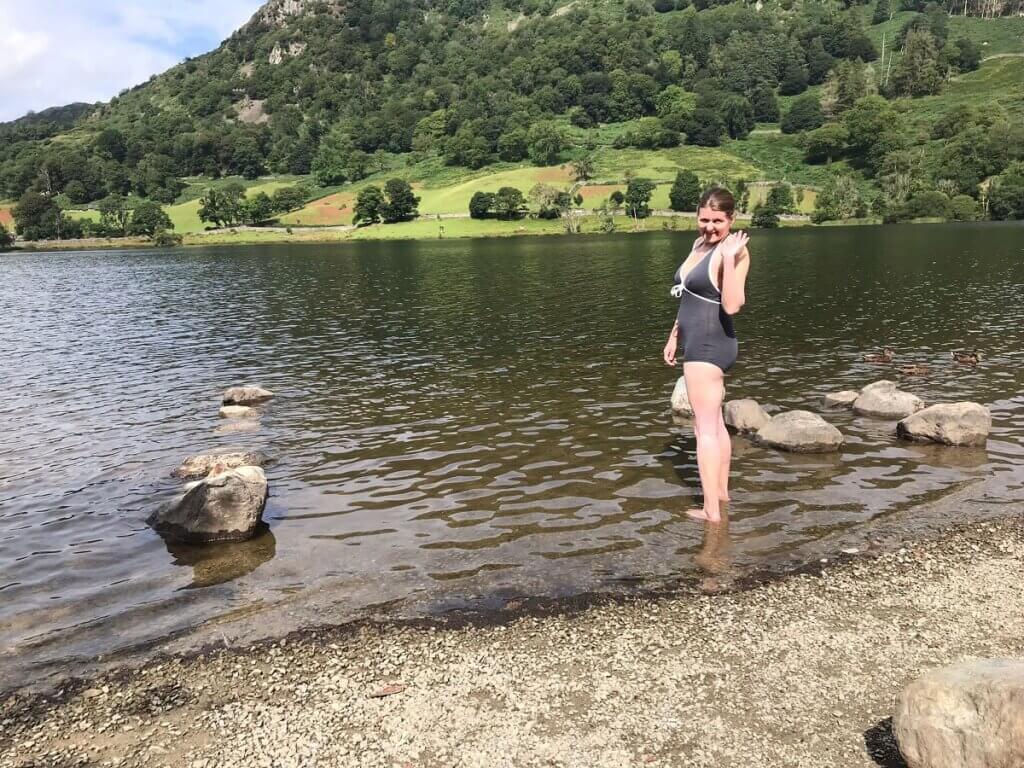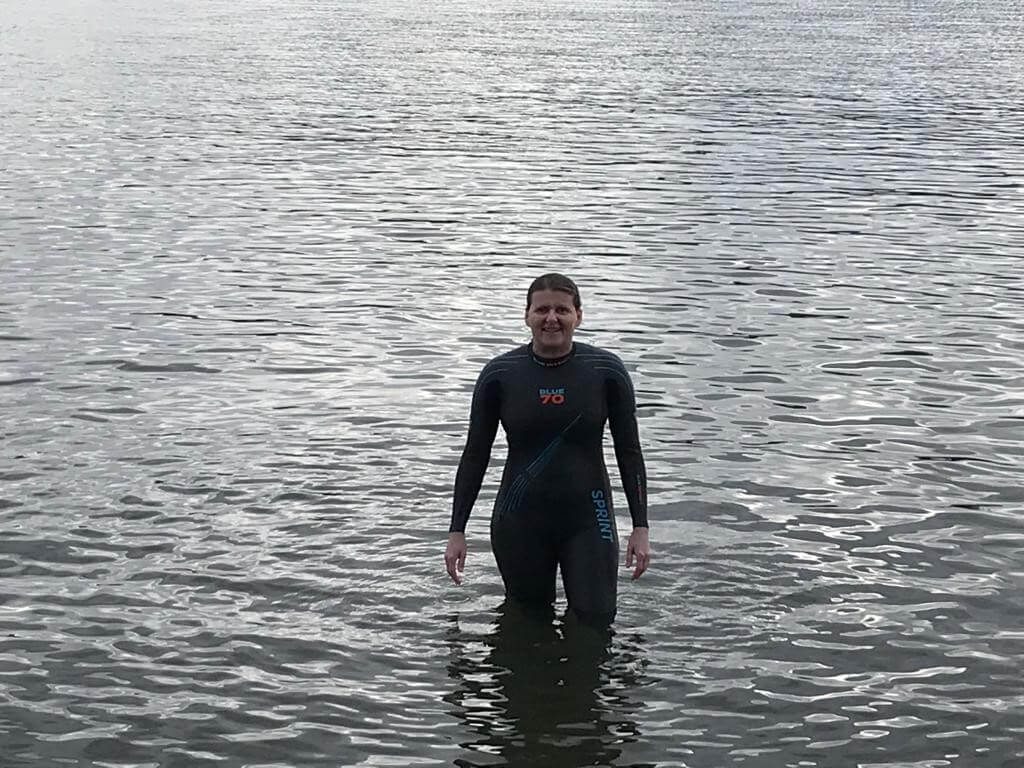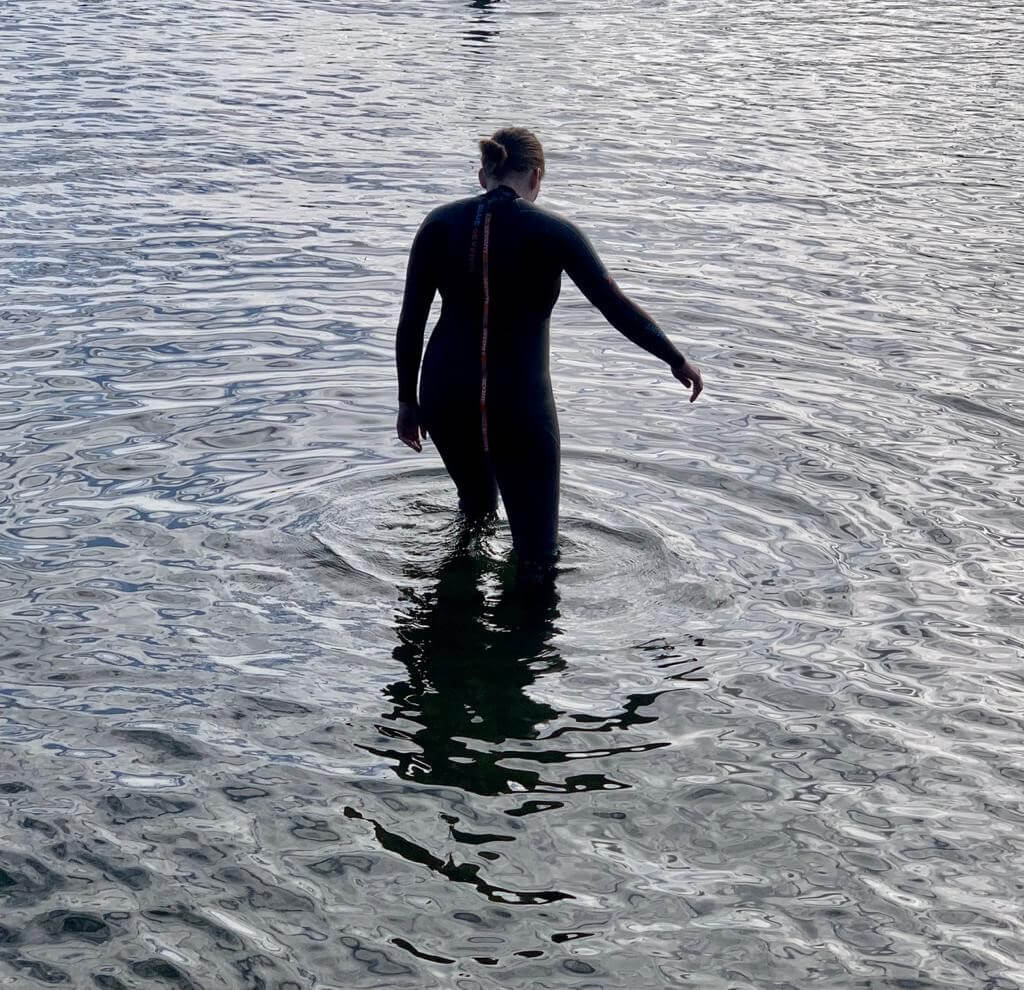Since discovering how incredible it feels to swim in fresh water over the last few years I always wished I could get my own wetsuit. I always assumed they would contain latex but this year I now have my very own wetsuit which I don’t react to. I’m so excited to start doing more wild swimming.

Why swim in fresh water if you have eczema?
So many reasons people; apart from the obvious one, it’s exhilarating and feels amazing, here are my top reasons why fresh water or wild swimming is great for eczema skin:
- No chlorine – Chlorine can irritate and dry out sensitive skin so fresh water wins hands down
- Cold – The change in temperature to being in cold water is absolutely amazing at calming skin and reducing inflammation. Check out the Wim Hof technique to find out more about the benefits of cold water therapy.
- Reduces anxiety – Once you can get over the terrifying fear that you can’t see what’s below you in the depths and maybe reeds and things touching your skin… ewww! Seriously, once you’ve got into the water the tranquility and relaxation I experience is like nothing else. Obviously you need to find a quiet lake to swim in, but it’s so freeing. I lay back and look at the sky and my body just relaxes.
- Exhilarating – Getting into cold water is a shock to the system. The first dunking of the intimate parts and then the shoulders is both shocking and then absolutely mind blowing. You soon start to acclimatise – depending on how cold the water actually is. If you’re swimming in skins ie, no wetsuit, make sure you don’t say in for too long. Get out as soon as you feel cold and get warmed up. If you’re in a wetsuit, the cold water slides in between your skin and wetsuit and creates a warm barrier around your skin, meaning you can stay in the water for much longer!
- Stops me itching – probably the cold shock of getting in, the effort it takes to stay afloat, the concentration of swimming, the shared joy of doing it with friends – I never swim alone. Unless you are very experience never swim alone and always wear a bright coloured swimming cap and float to make sure you are visible to boats and other water craft. Back to the itching, I just don’t itch while I’m in cold water and it feels amazing. By contrast swimming in heated chlorine pools can make me very itchy.
I still sometimes get a bit nervous about swimming in fresh water. It’s often tricky to get into the water with stones to hobble over and slimy rocks and who knows if it’s polluted? Will it irritate my skin? I do worry, but if you make sure you choose places you know are safe it’s a truly liberating experience.
Last month I took my swimming costume with me on a walk and swam in Rydal lake, half way round the walk. WoW – honestly that was on my bucket list of crazy things I wanted to do when my skin was healed and it was incredible. I loved it!
You can’t always swim all year round in the UK, not in just swimming costume anyway. Whilst many people do dip in just skins, they can’t stay in for long. So the subject of wetsuits come up… and how do I find one that’s safe for my sensitive skin?
Do wetsuits contain latex?
Wetsuits are made from neoprene which is naturally latex free, so are they safe for people with a latex allergy? Neoprene wetsuits are made from petroleum oil and limestone so there is an environmental impact to their production and disposal, but with careful use these should last you for up to ten years. Here are few questions to ask if you’re looking to buy a latex free wetsuit:
- Glue and adhesives – They can also contain adhesive in the seams and this glue can also be an irritant. If you have a latex allergy the chances are most plasters and many glues will cause irritation, I have to guy hypoallergenic plasters as all of the adhesive glues cause a complete breakdown and blistering of the skin. Check out 100% Sheico suit which uses solvent free aqua based glue www.sheico.com
- Latex in cuffs, ankles and neck buffs – Some wetsuits do contain latex in the cuffs and ankles and collar buffs, so if you have a latex allergy be very careful to check.
Always ask the manufacturer for a guarantee that the product you wish to buy does not contain any latex.

Neoprene allergy
As you all know by now, people can be allergic to anything. Since Neoprene is a man-made fibre, invented to mimic rubber, some people do experience an allergic reaction or irritation when wearing them. Whilst neoprene allergy is rare it can be problem if you love watersports.
Reactions to neoprene include itching, rashes and swelling.
There is an alternative material called Yulex which is safe for anyone allergic to neoprene and should also be OK if you have a latex allergy. Since it’s actually made from rubber and also more expensive I didn’t go down this route for myself.
Yulex allergen free wetsuits
You can buy Yulex wetsuits from a number of places online but one website I found was Patagonia. They are 100% free from neoprene.
This purified natural rubber latex used in Yulex wetsuits significantly reduces impurities naturally found in rubber production, especially those allergens that cause potential for Type 1 Latex Allergy.
Yulex also has way less carbon footprint because it’s natural and plant based.
They are however a little bit more pricey, with a full arm and leg women’s Yulex wetsuit coming in at between $400 and $500.
Guayale allergy – can you be allergic to a Yulex wetsuit?
I also found a thread on a forum from someone who had a bad skin reaction to a Yulex wetsuit. They’re made from the Guayule plant which can be a severe skin irritant for contact dermatitis and cause a serious itchy skin rash. I can’t find any other evidence of this but maybe try to get a sample swatch to test.
Someone somewhere can be allergic to anything, don’t go out into open water before wearing any wetsuit for at least ten minutes to make sure it’s not irritating your skin.
Swimming and diving with asthma – is it safe?
If you have asthma there is always a higher risk for outdoor swimming. Even people who don’t have asthma can experience anxiety and panic whilst out in deep water and it can affect breathing. This is the reason why swimmers should always take a float, ideally wear a wetsuit and never swim alone.
I do have asthma and have not had any problems swimming. If you’re careful and take the right precautions.
- Don’t swim in open water if your asthma is bad and you feel wheezy
- Always take a float
- Never swim alone
- If you have a wetsuit wear it for added buoyancy
- Always take a puff of your blue inhaler before swimming
- Be careful what wetsuit you buy. I borrowed a sailing wetsuit once which was very restrictive and did make it hard for me to breathe. If you have a swimming one you should be OK.
- Relax your shoulders and breath gently, in through your nose and out through your mouth if you become anxious and start wheezing while on the water. Tell friends, ask for help and make for shore immediately. Back stroke can be easier if struggling to breathe.
Stay safe guys!
I actually find swimming to be a relatively low impact (I’m not a fast swimmer) activity and as I get fitter it helps me feel stronger and will help lungs to function more effectively.
Other things to consider with water sports and latex allergy
- Water shoes – Be careful when choosing water shoes as many of them are rubber. You can buy neoprene socks for swimming
- Goggles – The strap can be made from rubber elastic so make sure you do your research and find a latex free alternative.
- Swimming cap – Some of these are also made from rubber. Shop around and buy one made from neoprene or silicone.
- Scuba diving – There are many potential sources of latex in diving equipment, from the bungee neck chord to the tubes and mouthpiece. The strap on the mask
Which latex free wetsuit did I buy?
I would like to thank my aunt for taking me wetsuit shopping. They are not cheap items to buy and I probably would have taken much longer to take the plunge without Ro’s encouragement and support. Thanks Ro! We went to the wonderfully helpful Swim the Lakes in Ambleside in the Lake District and were assured that the Blue Seventy wetsuit was latex free
Details from Wiggle on the Blue Seventy wetsuits they sell says this: “A combination of thin neoprene and exposed super stretch jersey in the arms, shoulders and back provide excellent movement and reduced restriction. Thicker Yamamoto rubber at the chest and legs gives swimmers the initial confidence and buoyancy they need. “
From the Yamamoto website: YAMAMOTO Rubber is high-quality, warm, and flexible rubber foam made from Limestone. It has been used as wetsuits material by world’s Triathletes, Swimmers, Freedivers, Surfers, Spearfishers, Divers, and also used as orthopedic supports for human and animals.
This is what they said to me when I emailed to query what it was made from due to the incredibly strong latex odour “Our website description of the Sprint wetsuit states that it is made from 100% Yamamoto rubber, a premier manufacturer of neoprene. All wetsuits are made of neoprene. Blueseventy confirm that it is latex free.”
Swim the Lakes told me that my Blueseventy Sprint wetsuit contains no latex in the neoprene. Sprint wetsuit states that it is made from 100% Yamamoto rubber, a premier manufacturer of neoprene. The label inside the website says “Vulcanised rubber” The use of rubber in the description really confuses me though, because this wetsuit does have a strong rubbery smell.
What is vulcanised rubber?
Vulcanized rubber is any type of rubber that’s been hardened through the use of heat and sulfur. It’s made via a curing process in which the rubber’s elastomers harden in response to heat and sulfur. Exposure to heat and sulfur creates new cross-links in the rubber that, ultimately, makes the rubber stronger and more elastic. Vulcanized rubber is natural latex that has undergone a process by which the rubber is heated and sulfur, peroxide, or bisphenol. This improves the latex’s elasticity, resistance, and longevity. What’s great about vulcanized rubber is that it’s still biodegradable. Source: One Monroe.
Clearly this isn’t latex free, it’s made from latex, so how can a wetsuit manufacturer AND the company selling those websites be telling me, the customer that it’s neoprene? It’s baffling.
And why, am I am able to wear it without irritation? I have a diagnosed, confirmed serious latex allergy so why doesn’t this wetsuit cause skin irritation? And will it become more irritating as it ages? I would love to hear from any experts out there who can help me shed some light on this.
What is neoprene made from?
Neoprene fabric is created through a complex chemical process known as free radical emulsion polymerization. Basically, this process takes normal chloroprene and turns it into the synthetic version known as polychloroprene. Essentially what this means is that the fabric is created by turning a liquid into a solid. What Is Neoprene Fabric?
First developed in the early 1930s, neoprene material was the first successful synthetic elastomer to hit the market. With World War II raging, natural rubber materials were becoming scarce which led to the United States’ discovery of chemically engineered neoprene elastomers. This new neoprene material was made with the intention of replacing natural rubber with a stronger and more resilient synthetic rubber.
So neoprene is latex free, instead being made to mimic and be like rubber. Some neoprene also advertises itself as limestone neoprene!
Why do wetsuits smell so bad? and what to do about it
It’s the one downside to the one I bought (vulcanised rubber), it stinks out whatever room it’s in. Not found a solution to this yet and hoping the smell fades or I find solution to the smell. I’ve soaked mine in white vinegar which helped a bit, I always wash it after use by showering it in warm water and hanging to dry, so why does it smell so horrible? I may have to sell it and buy a neoprene one (which is what I wanted in the first place anyway. Very cross with the shop I bought this one from. But anyhoo, having found on focus groups and forums that the bad smell of wetsuits is a common problem here are some possible solutions:
- Once you remove the suit let it dry without rinsing it off to help prevent further odors from developing. Fill up your bathtub with warm water. Wash your suit, the dish washing detergent is especially good at breaking down the oils and also helps to get off bacteria in the wetsuit.
- Put it in the freezer for a few hours (not sure about this one! but might be worth a try)
- Another guide says this: Make sure you always rinse out your wetsuit with fresh water as soon as possible after getting out of the water and then leave it out to dry. Doing this every time will help keep the odors to a minimum.
- Don’t put it in the washing machine as this could deteriorate the wetsuit
- Don’t let it fall on the dirty ground – put down a towel to lay it on when you get changed
- Don’t pee in it!
- Don’t wash in too hot water – cold rinse after every use should work well
- Don’t leave wet it a bag, always wash and hang to dry
- Store it hanging up so it can air
I hope this helps, now I am a wetsuit expert!
The cost of buying a wetsuit?
You should be able to purchase a basic first timers neoprene wetsuit for under £200. This may sound expensive, but if you take care of your wetsuit it should last you ten or more years. You can buy them for at little as £74 if you shop around. The more technical the wetsuit, obviously the more expensive they are. You can also get ‘shorty’ wetsuits that aren’t full body covering which are cheaper. Make sure you buy a ‘swimming’ wetsuit as opposed to a surfing or boarding suit as the latter are stiffer and less flexible and not easy to swim in.

Wetsuit brands to look for
- Jobe Sports sell neoprene wetsuits and gloves
- Blueseventy are neoprene – links above
- Osprey sports do a range of full body and shorty swimming wetsuits
- https://www.wetsuitoutlet.co.uk/ also do a range of different neoprene wetsuits
- Decathlon do a range of very affordable neoprene wetsuits
What’s it like swimming in a wetsuit?
I was so thrilled to enjoy an hour swimming in Lake Windermere, having not managed to get to the shops till the last day of the holiday! It made such a difference, for me the most amazing part of wearing a wetsuit was the added buoyancy. I found that I barely needed to even tread water to stay afloat, and it kept me high in the water when swimming. The buoyancy element of the suit was focused on the torso so I did find it slightly more challenging to do breaststroke. Interestingly, most wet suits are designed for front crawl and back stroke. However, I worked out a way of incorporating breaststroke and managed to enjoy this hour-long experience without getting cold at all! Switching between back stroke and breaststroke meant I could enjoy the view and conserve my energy. I have no direction when doing back stroke so keep veering off route and need to check all the time. The water in the Lakes is so warm this summer due to the incredibly good weather we’ve been having so I almost didn’t need a wetsuit.
Kit list for wild swimming
Now I’m becoming an expert (I can count on both hands my number of wild swims, but I’m hooked! Swimming outdoors is more fun if you are prepared for the cold, so here is what I take:
- Towel – seems obvious, but easily forgotten. If you can take a large absorbent towel. You can also get lightweight microfibre quick drying towels for really wild swims.
- Hand towel – To stand on! This makes getting dried off a little kinder on the feet, you can stand on this one while you get dried.
- Swimming cap (essential) and goggles (optional)
- Layers – Warm hat, gloves, extra think layers, thick socks and scarf – you’ll really appreciate this when you get out.
- Flask with hot drink – Some venues have a coffee van but not all.
- Waterproof bag – to stuff in your wet swimsuit, wet suit, damp towels etc.
- Tow bag – if swimming alone, and to carry your money, phone etc.
- Snacks – you’ll thank me afterwards
- Knickers! (if you go wearing your swimsuit)
- Booking reference – it’s often cheaper to pre-book
- Loyalty card – Ask for one of these! Most places do them, and you usually get your tenth swim free
- Wet suit – Obviously! and wetsuit shoes/feet if you have them
- Money – for a coffee
- Dry Robe – You’ll see people with these thick waterproof full body length coats to put on after your swim. They allow you to get warm and enjoy the social ambience after your swim, sit by the lake or river and soak up the atmosphere. These are very expensive. If you’re after a cheaper alternative, I bought a towelling style one or a fraction of the cost and it does the trick. I prefer to get dry and fully dressed pretty quickly anyway.
Swimmers, have I missed anything?
Get out of your comfort zone and try fresh water swimming
Get out here, if you want to swim in fresh water, do it! I highly recommend the experience. Do check pollution levels and choose lakes with special swim sessions, and always swim with others.
I’d love to try the Wim Hof technique, but it seems to encourage excessive water use which puts me off. The idea being immerse your body in very hot water, then cold for as long as you can, then hot and then cold again. You extend the length of time under cold water and it reduces inflammation and anxiety. I do end each shower with a cold burst though and it feels so amazing. Try it if you haven’t already. Hot showers can trigger an itch attach for me so ending with cold water helps avoid that.
Are you a wild swimmer? I’d love to hear your thoughts.
Do you love swimming outdoors or do you steer clear because of your skin or fear of the deep dark down there!
I’d love to hear your experiences and hope you found this blog useful.
Have you had an allergic reaction to a wetsuit?
Other useful resources
- Join NOWCA to get access to lots of outdoor swimming locations
- Find open water locations throughout the UK at swimming.org
- The UK Outdoor Swimming Society
- Cold Water Swimming – Benefits and Risks
- International Ice Swimming – no wetsuits allowed here!
- Wild Swimming Australia












Leave a Reply